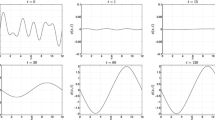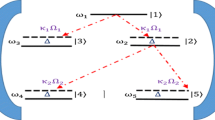Abstract
A hybrid algorithm, which couples rigorous time-domain electromagnetic analysis with rate equations representing a multi-level atomic system, is presented in this paper. It is explicitly shown that the rate equations can be decoupled from Maxwell curl equations, provided that the evolution of both systems is ongoing on different time scales. Consequently, the proposed algorithm allows substantially speeding up electromagnetic analysis of absorbing and lasing materials with no deteriorating impact on accuracy. Several computational examples, pointing out major properties of the proposed hybrid FDTD algorithms, are presented in this paper.










Similar content being viewed by others
References
Chang, S.-H., Taflove, A.: Finite-difference time-domain model of lasing action in a four-level two-electron atomic system. Opt. Express 12(6), 3827–3833 (2004)
Chow, W.W., Koch, S.W.: Semiconductor-Laser Fundamentals: Physics of the Gain Materials. Springer, Berlin (1999)
Fafin, A., Cardin, J., Dufour, C., Gourbilleau, F.: Modeling of the electromagnetic field and level populations in a waveguide amplifier: a multi-scale time problem. Opt. Express 21(20), 24171–24184 (2013)
Fang, A., Koschny, T., Soukoulis, C.M.: Lasing in metamaterial nanostructures. J. Opt. 12, 1–13 (2010)
Hagness, S.C.: FDTD computational electromagnetics modeling of microcavity lasers and resonant optical structures. Ph.D. Dissertation, Electrical Engineering and Computer Science, Northwestern University, Evanston, IL (1998)
Nagra, A.S., York, R.A.: FDTD analysis of wave propagation in nonlinear absorbing and gain media. IEEE Trans. Antennas Propag. 46(3), 334–340 (1998)
Salski, B.: Hybrid FDTD modeling of a two-level atomic system. In: 14th International Conference on Numerical Simulation of Optoelectronic Devices, Spain (2014)
Siegman, A.E.: Lasers. University Science Books, Mill Valley, CA (1986)
Acknowledgments
The research leading to these results has received funding from the Polish Ministry of Science and Higher Education under Grant Agreement No. 0550/IP2/2013/72 (Iuventus Plus). The author would like to thank Dr. Kamila Lesniewska-Matys for fruitful discussions on to the proposed hybrid technique.
Author information
Authors and Affiliations
Corresponding author
Rights and permissions
About this article
Cite this article
Salski, B. Hybrid FDTD analysis of two- and four-level atomic systems. Opt Quant Electron 47, 1703–1712 (2015). https://doi.org/10.1007/s11082-014-0027-8
Received:
Accepted:
Published:
Issue Date:
DOI: https://doi.org/10.1007/s11082-014-0027-8




